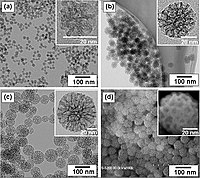
Photo from wikipedia
Abstract The main focus of the article is the study of function mechanisms of a magnetron sputtering system (MSS) with a heat-insulated metal target in a self-sputtering gasless mode. A… Click to show full abstract
Abstract The main focus of the article is the study of function mechanisms of a magnetron sputtering system (MSS) with a heat-insulated metal target in a self-sputtering gasless mode. A distinctive feature of the studied case is that the target evaporation takes place along with its sputtering. The research has been carried out on a copper target sample in molybdenum crucible. It has been found that because of evaporation the MSS can function stably using metal vapors without sputtering gas. The pressure in the chamber is 0.01 Pa. The current-voltage characteristics and spatial distribution of the copper atoms concentration near the target have been determined at the power density from 14 to 72 W/cm2. The minimum power density necessary for a stable gasless self-sputtering mode is 19.4 W/cm2. Herewith the evaporated particles constitute approximately 87% of the total number of copper atoms near the target. It has been found that the erosion coefficients of metal targets at evaporation reach several tens of atoms per ion, which is an order of magnitude higher than the sputtering yield. Due to this, the coatings deposition under self-sputtering conditions takes place without reducing a deposition rate as compared to the case with sputtering gas.
Journal Title: Vacuum
Year Published: 2018
Link to full text (if available)
Share on Social Media: Sign Up to like & get
recommendations!